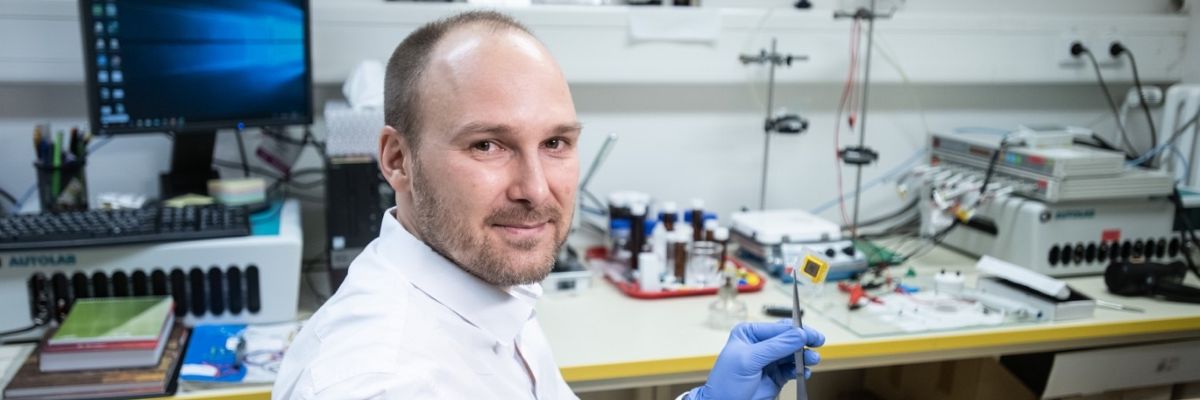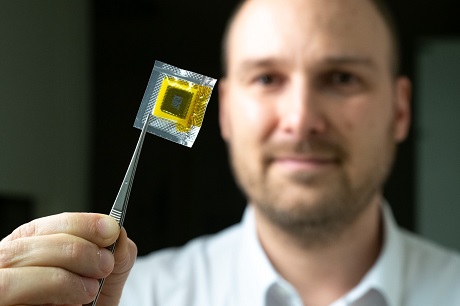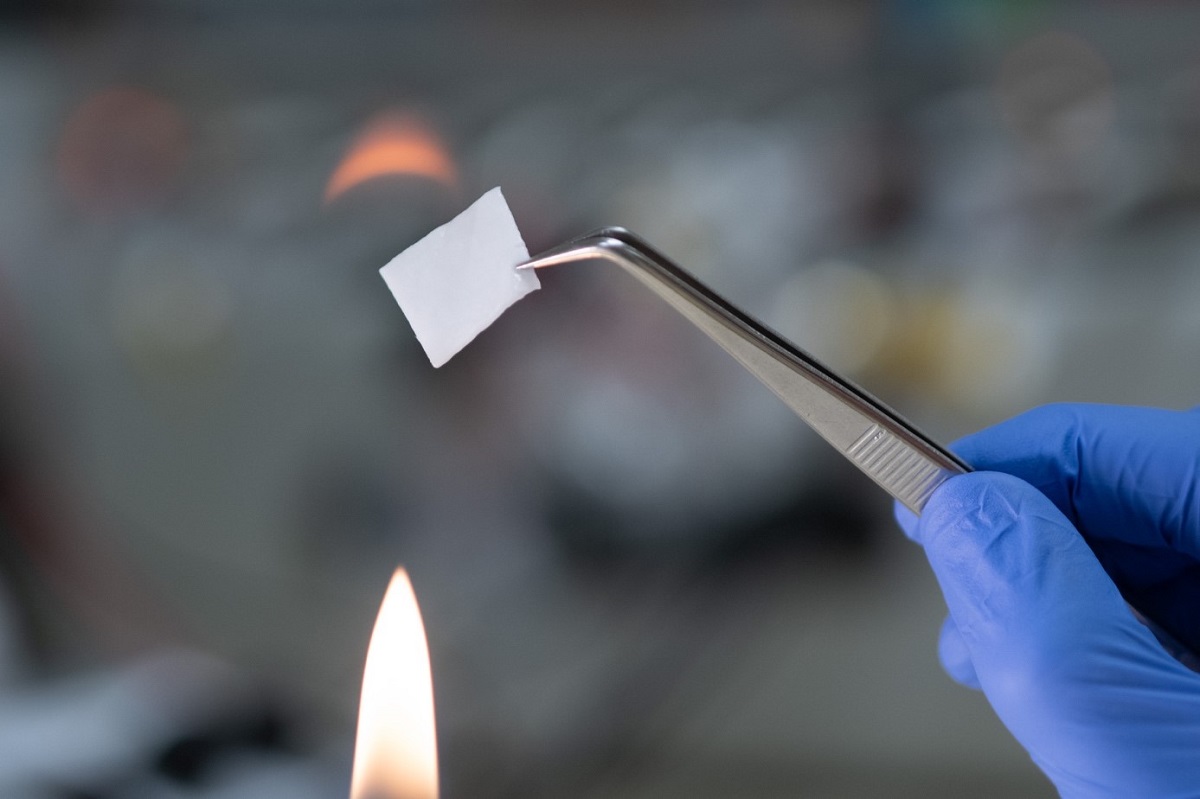
A revolutionary patent: a cheap and safe high-capacity battery
10. 02. 2022
It does not catch on fire or explode. It is made from extremely cheap and recyclable materials, withstands five hundred discharge/recharge cycles, and its capacity is comparable to commercial nickel-metal hydride batteries. Scientists from the Institute of Physics and the J. Heyrovsky Institute of Physical Chemistry of the Czech Academy of Sciences (CAS) have developed a new type of rechargeable battery that brings a revolution in technologies. It may find application, for example, in the field of solar energy storage.
Storing the electricity generated by solar or wind power plants is a major challenge. Although there are a number of innovative battery types on the market, most of them are not suitable for high-capacity electricity storage, mainly because of their high cost. The advantage of the new battery is the high voltage and materials used, which are cheap and widely available. The battery comprises saline water electrolyte, zinc, and graphite. It works on the principle of electrochemical redox reactions.
"Aqueous batteries have already been introduced before, but their relatively low capacity and voltage prevented their widespread. Our team has managed to overcome this problem by adding large amounts of the chaotropic salt of zinc perchlorate in the water solution," explains Jiří Červenka, the team leader from the Institute of Physics of the CAS.
The effect of chaotropic salt on the properties of aqueous solutions was studied more than 130 years ago by the Prague-based German chemist Franz Hofmeister. The team of scientists from the Academy of Sciences of the Czech Republic took inspiration from his findings and developed a battery that can be used, for example, in stationary battery systems.
"The voltage achieved in our battery is comparable to that of organic electrolytes in commercial lithium batteries. An indisputable advantage of our electrolyte is its high conductivity, which, unlike in organic electrolytes, does not drop significantly even at low temperatures," says Jiří Červenka.
The researchers find the use of the battery at places where it can be permanently installed – for example, in solar panels. The advantage is that it can store energy even in case of the sun is not shining.
Explosion and ignition is out of the question
The battery does not catch on fire and cannot explode because it has a non-flammable electrolyte. This is a major difference from the most commonly used Li-ion batteries. Li-ion batteries use flammable organic electrolytes and lithium, which can spontaneously catch fire when exposed to air. "This is not a risk with our battery," emphasises Jiří Červenka.

Jiří Červenka believes that his team has found a breakthrough solution in electricity storage with the new battery.
The scientists have patented their innovative solution under Luxembourg and European patents. They have also published the results of their research in prestigious scientific journals, most recently in this week's Journal of Materials Chemistry A. They are currently looking for industrial partners interested in further product development.
"This system is extremely interesting not only for future applications but also from the fundamental research point of view. We have shown that the inner structure of the electrode material, for example, plays a very important role here, where too much perfection does not lead to the best properties in some respects. This may also be an added advantage for applications," says another team member, Otakar Frank from the J. Heyrovsky Institute of Physical Chemistry of the CAS, about the invention.

A new type of cheap, recyclable, non-flammable battery
The principle of the battery is based on the transport of two different ions – divalent zinc and monovalent perchlorate. The advantage of divalent zinc, compared to monovalent lithium, is that zinc can transfer two electrons per atom during the charging and discharging process. Hence, it can theoretically provide a higher capacity for a given volume than lithium.
The capacity can be further increased
The performed tests have shown that the experimental aqueous battery achieves a capacity of around 45 mAh/g, an output voltage of 2 V, and 500 discharge and recharge cycles without a noticeable decrease in performance. The resulting capacity of the experimental battery is therefore comparable to the commercial nickel-metal hydride batteries.
"I believe that it is still possible to significantly increase the capacity of this battery after thorough optimisation," highlights Jiří Červenka. His team will now focus on high-capacity ion batteries. The aluminium aqueous battery, which the researchers have recently built on a similar principle, also seems very promising.
Text: Eliška Zvolánková and Markéta Wernerová, Division of External Relations, CAS Centre of Administration and Operations
Photos: René Volfík, Institute of Physics of the CAS
Read also
- A trapped state: The pandemic impact on public attitudes, trust, and behavior
- Aerial archaeology: Tracing the footsteps of our ancestors from the sky
- Archaeologists uncover ancient finds along Prague Ring Road
- Our microbiome largely depends on what we eat, says microbiologist Michal Kraus
- The ABCs of writing: Why did its invention mark a turning point for humankind?
- We learn, remember, forget… What can memory actually do? And can we outsmart it?
- New Center for Electron Microscopy in Brno opens its doors to global science
- The hidden lives of waste: What can we learn from waste workers and pickers?
- A unique lab is hidden right beneath Prague’s Vítkov Hill
- Renewables are a strategic investment in European security, scientists say
The Czech Academy of Sciences (the CAS)
The mission of the CAS
The primary mission of the CAS is to conduct research in a broad spectrum of natural, technical and social sciences as well as humanities. This research aims to advance progress of scientific knowledge at the international level, considering, however, the specific needs of the Czech society and the national culture.
President of the CAS
Prof. Eva Zažímalová has started her second term of office in May 2021. She is a respected scientist, and a Professor of Plant Anatomy and Physiology.
She is also a part of GCSA of the EU.